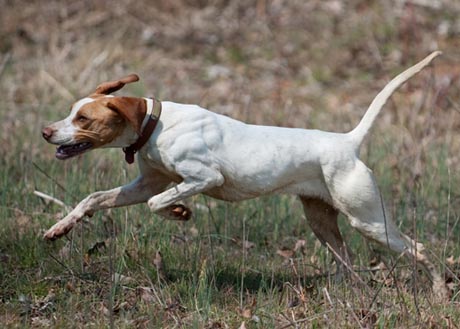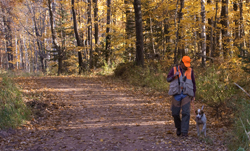Range

The purpose of a pointing dog is to hunt, find birds and point them until the shooter arrives. Unlike flushing dogs, they are supposed to hunt outside of shotgun range and find birds the hunter would not have found otherwise
…And range, although it is partly governed by training, is basically in the blood. Anything you do to alter it requires continued effort.
~ George Bird Evans, Troubles With Bird Dogs
The distance a dog hunts, or makes casts, from its handler is referred to as its range. Range is a genetic quality that can be selectively bred just as square heads, long legs and desire for birds. Consequently, a dog is born with a tendency to hunt at a certain range. If two wide-ranging dogs are bred, odds are the offspring will also be wide ranging. The same can be said for close- and medium-ranging dogs. This inherited range can be modified through training, but trying to make drastic changes can have a negative impact on a dog’s hunting ability.
Range is somewhat difficult to describe because dogs don’t consistently hunt at a specific distance from the handler. While a dog hunts, it is either going away or checking in with the handler. A dog that will willingly make contact, either visually or by sound, at frequent intervals during the hunt is said to be handling. This checking, to a large extent, determines the dog’s range.

In open country, the dog might see the handler from several hundred yards away but in tight cover that distance might be less than 20 yards. Making contact confirms the whereabouts of the dog and that it is hunting in the right direction. Our grouse dogs may make casts of 100 – 200 yards through the woods—depending on the density of the cover—but at the end of each cast, they hunt their way forward and make eye contact as they cross in front. As an alternative, they might stop and listen for our whereabouts before continuing to hunt.
Good hunting dogs are divided into three classes: wide, medium and close ranging. It is not practical to try to make a close-ranging dog out of either of the two other classes. You positively cannot make a wide ranging dog out of a close-in hunting dog. The wide and medium range dogs should be trained so that they will hunt close in under restraint. After the restraint is lifted, they will revert to their natural range.
~ Er Shelley, Bird Dog Training Today and Tomorrow, 1921
A common thought is that a wide-ranging dog finds more birds because it covers more territory. Actually, though, two dogs hunting at the same speed can only hunt the same amount of ground. The difference lies in what ground was hunted. This is where coverage of ground comes into play.
A wide-ranging dog may cover more linear distance, but it doesn’t cover that ground as thoroughly as a closer-ranging dog. Depending on the nature of the terrain being hunted, this could make a difference in which type of dog finds the most birds.
At Northwoods Bird Dogs, we favor a well-conformed, athletic dog with a strong desire to find birds; and one that has the ability to adapt its range using intelligence as opposed to one with circumscribed range because it is physically inferior or lacks desire. Our type of dog will naturally adjust its range and speed depending on the terrain being hunted and the pace of the handler. This dog will hunt wider in prairie, desert or field edges, but shorten up its range in thick or wooded areas. Along with increasing their range, they will also increase their speed when hunted in open areas.
Some dogs have the ability to adapt their range to different types of country and handle themselves properly no matter what type of terrain they are asked to work. But this quality is unusual and valuable, indeed, when a dog possesses it in a marked degree.
~ Henry P. Davis, Training Your Own Bird Dog, 1948
For a dog to have such an adjustable range, it must not only be intelligent but must have a strong desire to work with and please its handler. The latter quality falls under the broad category of “trainability” and is one of the most important traits in a dog. A trainable dog will allow its range, and other habits, to be more easily modified and without the side effects of one that is less trainable.
Top photo of Northwoods Vixen taken by Chris Mathan, The Sportsman’s Cabinet.




